|
Math Professor Julia Wilson, above, organizes Pi Day.
|
Pi Day is observed worldwide on March 14, because the common three-digit approximation for the number Pi is 3.14. Although Pi is the ratio of the circumference of any circle to its diameter, the size of the circle never changes the value of Pi.
The fun starts at Fredonia at 3 p.m. with the Pi Olympics, featuring games that pit students’ math skills against one another’s as they compete in wacky games using mathematics to solve problems fast and win prizes. The Hextreme Relay for example demands its players to fit hexagonal tiles together, but first they have to run a short race to fetch the tiles. In Cutter Curling, the teams have to determine their starting positions in an iceless version of the sport. In House of Cards, each team will have to assemble a house of cards that can support a stack of pennies. The fast-paced game of Smadness will require the students to use four random numbers and basic arithmetic to produce all the numbers from 1 to 10.
Pi Day is organized by a committee of department faculty who include Julia Wilson (committee chair), Robert Rogers, Lan Cheng, Keary Howard, Rebecca Conti, Dana TeCroney, and LeeAnn Mislin.
Parties like those at SUNY Fredonia will be held by math students and faculty throughout the world, thanks to Pi’s unusual characteristics. In 1999, Yasumasa Kanada at the University of Tokyo calculated Pi to over 206 billion digits, none of which comprised either a pattern or a repeating string. Pi has an iconic status in the world of math, where the number continues to challenge the most calculating of minds.




